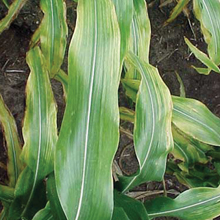
Postassium-deficient corn will show yellowing at the leaf tip and leaf margins.
A balanced crop nutrition program isn’t done boosting yields after the seed is planted. The role of proper nutrition in preventing disease is often overlooked. The nutrient status of the plant substantially influences the potential degree of disease infection by affecting growth and chemical composition of the tissues. The risk of infection is lowest when an optimal nutrient supply is available (Figure 1).
Protecting plants from disease is a key function of protecting yields, and it takes a comprehensive approach to nutrient planning to get those extra bushels to the bin. Research demonstrates that micronutrients, including zinc (Zn), can make a big difference at the end of the year.
Current research has shown boron (B), manganese (Mn) and calcium (Ca) can significantly inhibit disease invasion in plants by stabilizing and maintaining structural integrity and rigidity of the cell wall. Additionally, if deficient in magnesium (Mg) and potassium (K), plants are more susceptible to infection from airborne pathogens because leaf tissue increases in soluble sugars and amino acids. Zn plays a critical role in plant disease tolerance and should be considered as a preventive solution in a disease management plan. Adequate plant nutrition can improve the drought and head-stress tolerance, which in turn might help the plant stave off fungal infestations from Aspergillus, which causes aflatoxins that can destroy crop values.
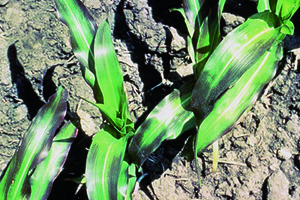
Phosphorus deficiencies manifest themselves in purple discoloration of the lower leaves.
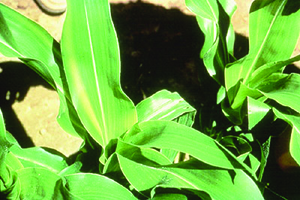
Zinc deficiencies are detectable by yellowing at leaf collars that progress from lower to upper leaves.
Keep plants healthy with zinc
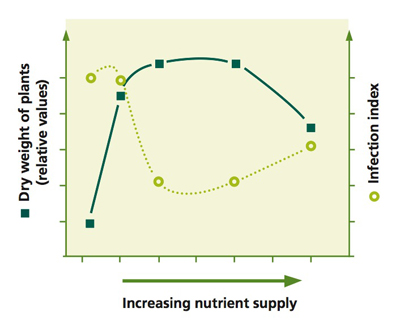
Relationships between nutrient supply, dry-matter production (growth) and pathogenic infection in plants (modified from Marschner, 2012).
The structural and functional integrity of root cell membranes is critical in preventing disease. When root cell membranes lose stability and function, the effect is twofold: First, when roots are more permeable, they have weakened defenses against pathogen attacks. Second, the sugars and amino acids released by unstable cell membranes attract and support pathogens subsisting in the soil by providing an excellent feeding substrate and promoting rapid germination of spores.
Zn plays a key role in maintaining structural integrity of cell walls. Plants deficient in Zn are more susceptible to root diseases. Likewise, applying Zn fertilizers has been shown to reduce infection from these root diseases. In particular, a study of Rhizoctonia solani infection levels in wheat showed that applying Zn to ensure an adequate supply dramatically reduced the degree of infection (Figure 2).
In addition to affecting root disease tolerance, Zn may also play a role in airborne pathogen tolerance. When deficient in Zn, plants’ biosynthesis of proteins is inhibited and an extensive accumulation of amino acids occurs. This is similar to the increase in susceptibility to airborne disease found when Mg or K is deficient and leaves accumulated sugar and amino acids.
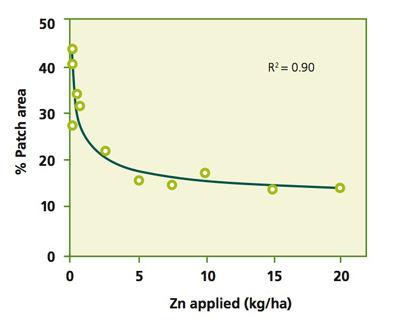
Relationship between bare patch caused by Rhizoctonia and soil Zn supply in wheat (drawn from Thongbai et al., 1993; Plant and Soil).
Preventing disease, rather than trying to mitigate its effects once it is established, is vital to effective disease management in today’s cropping systems. Balanced crop nutrition plays a key role in helping to prevent disease infections, and is another valuable tool in your toolbox to manage disease.
Datnoff, L.E., Elmer, W. and Huber, D. (eds.). (2006): Mineral Nutrition and Plant Disease. APS Press, St. Paul, MN.
Cakmak, I., Hengeler, C. and Marschner, H. (1994a). Partitioning of shoot and root dry matter and carbohydrates in bean plants suffering from phosphorus, potassium and magnesium deficiency. J. Exp. Bot. 45: 1245–1250.
Cakmak, I., Marschner, H. and Bangerth, F. (1989): Effect of zinc nutritional status on growth, protein metabolism and levels of indole-3-acetic acid and other phytohormones in bean (Phaseolus vulgaris L.). J. Exp. Bot. 40: 405-412.
Gérardeaux, E., Saur, E., Constantin, J., Porté A. and Jordan-Meille, L. (2009). Effect of carbon assimilation on dry weight production and partitioning during vegetative growth of K-deficient cotton (Gossypium hivsutum L.) plants. Plant and Soil, 324: 329–334.